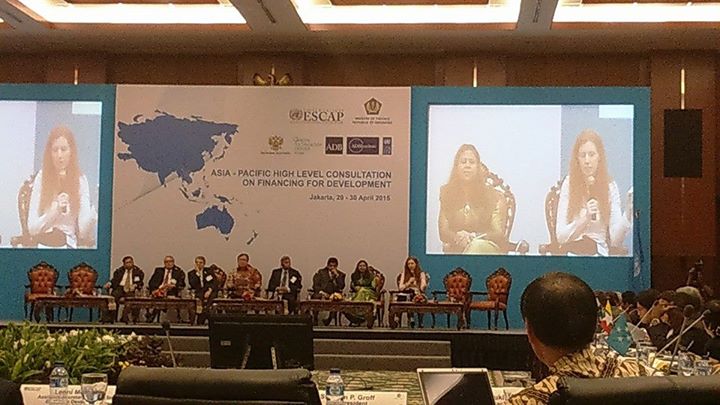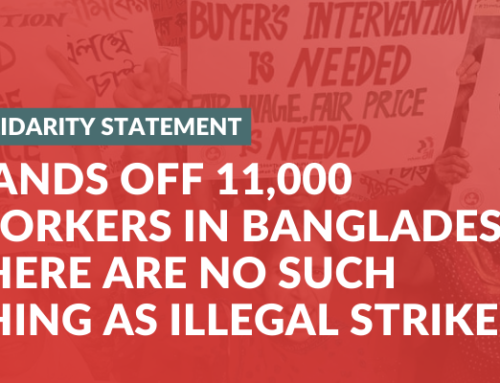Statement by Kate Lappin, APWLD regional coordinator. at the Asia Pacific high level consultation on financing for development, 29-30 April, Jakarta, Indonesia
Thank you to UNESCAP and the Government of Indonesia for including civil society in this opening panel and meeting.
Distinguished panelists, delegates, my civil society and UN colleagues.
We meet at a moment in history where governments have promised to create a more just and sustainable development agenda. We also meet at a moment where inequality has grown so high and so obscene that 85 people in the world hold as much wealth as 3.5 billion – half the world’s population[1]; within the year just 1% of the world’s population will hold more wealth than the remaining 99%[2]. Just 0.001% of the Asia-Pacific population in 2013 classed as UHNWIs, with about $7.5 trillion of net wealth in 2012-2013. In some countries in our region the net wealth of ultra high net worth individuals is half GDP. And their net wealth is 17 times more than the combined GDP of the Asia-Pacific least developed countries[3]and at a moment where the planet is perilously close to the climate tipping points where our planet will become uninhabitable; at a moment when accountable democracy is in terminal decline.
This meeting, and the Addis Ababa meeting can and must play a role in dismantling the sources of these crises and building a new world order.
In these few minutes I want to emphasis 5 points
- CBDR remains a core essential principle – a clear North South Divide persists
- Maintaining the Integrity of the FFD process
- Restoring the balance of the Addis Ababa Accord
- The growing reliance on the private sector in this agenda erodes development, equity and democracy
- The need to address systemic drivers of inequality and focus on redistribution.
1. A deep divide between wealthy countries and Developing countries persists which is why CBDR must remain a core principle. The idea that the world has changed so much that there are no longer differentiated responsibilities to address development is a fiction. In fact the inequalities of wealth, resources and power have deepened and historical responsibilities remain.1.2 billion people living in extreme poverty account for just 1% of global consumption while the richest 1 billion consume a staggering 72%.In 2010 high income countries, accounting for only 16% of the world’s population were estimated to generate 55% of global income. Low income countries created just above one per cent of global income even though they contain 72% of global population. The world remains deeply inequitable.
2. The post2015 and FFD processes are complimentary yet distinct processes. They must remain so.We stand to lose far too much by collapsing the FFD review into the HLPF. Governments must be held to account for all their commitments within FFD in a standalone annual intergovernmental commission with a negotiated political outcome. Similarly we simply cannot allow the FFD commitments to be shifted out of the UN and into institutions designed to favour rich countries – Bretton Woods, OECD,G20. The UN is the right venue for resolving key development challenges that overwhelmingly affect developing countries, like tax evasion, debt restructuring. The zero draft fails to acknowledge the important progress being made in the UN GA through the recent resolution on sovereign debt restructuring and instead emphasizes the OECDs work on tax evasion even though that forum excludes the vast majority of developing countries.This is but one example of the way that the zero draft is overwhelmingly weighted in favour of wealthy countries.
3. Restoring the balance of the agreement The draft is now weighted heavily towards the interests of TNCs and OECD countries. Key proposals in the elements paper that must be fully reflected include; agreeing on an official definition of illicit financial flows, and mandating impartial official estimates; agreeing on international minimum corporate tax floors and a consolidated corporate tax base; elaborating binding environmental, social and human rights standards for all investment agreements; safeguarding the right to regulate on health, environment, safety, financial stability, etc.; and a multilateral framework for sovereign debt restructuring.
4. Privatisation must not become official UN policy. We must reject the continuing emphasis on the private sector as a modality for development finance and implementation. The zero draft currently obscures the division between international and domestic private finance but we know that it is generally transnational companies and capital that take advantage ofPPPs.PPPs are clouded in secrecy yet the evidence against the public value ofPPPs is overwhelming.When public investment is driven by the desire for profit, which a PPP must necessarily provide, rather than public good, the results have been disastrous.
Indonesia’s own experience of PPPs in electricity and water provide a stark tale of the potential for corruption and the detrimental impact on communities. And if those tales are not enough, Investor State Dispute Settlement Clauses in investment treaties now make it virtually impossible to extricate a state from a detrimental PPP.ISDS allows corporations to sue sovereign governments in opaque tribunals and ignore national laws. It essentially allows corporations to regulate states when what we desperately need is for states to regulate corporations. Corporations extract 1 trillion dollars from developing countries through tax evasion in one year.ISDS provisions have been used to challenge pro people public policies in environmental regulation, regulation of finance and banking, minimum wage setting, provision of water and public health policy. It is alarming that the G77 apparently consents to removing the ISDS review clause within the zero draft.
5. We must reject the fiction that extractive growth is the remedy for development. The extractive growth model is utterly incapable of eradicating poverty. Since the promises of Monterey and Doha the poorest 60% of the world received a mere 5% of income generated by global GDP growth, while the richest 40% received a staggering 95%[4]. We do not have a wealth problem, we have a distribution problem.Recently,economists considered how much consumption would be required to lift everyone out of poverty to the meagre level of $5 per day. A rate that is far below the poverty line of many countries in the region and far below a dignified livelihood. They found that current patterns would require consumption to be increased 175 times per person per annum to eradicate poverty.[5]Of course this planet has finite resources and we are nearing environmental tipping points that will lead to catastrophic climate change. The extractive growth model will only eradicate poverty by eradicating the poor and, eventually, all humanity.
So we are left with one option only. One option that this meeting and the Addis Ababa meeting has a clear mandate to deliver, one option that must frame the accord – redistribution. It is only through redistribution of resources, opportunities, power and wealth between countries, between rich and poor and between men and women will we survive and prosper. It is only through redistribution that we will achieve Development Justice.
Thank you.
[1] Oxfam, ‘Wealth: Having it all and wanting more’ 2015. www.policy-practice.oxfam.org.uk
[2] Oxfam, ‘Wealth: Having it all and wanting more’ 2015. www.policy-practice.oxfam.org.uk
[3] UNESCAP Economic and Social Survey of Asia and the Pacific 2014 http://www.unescap.org/resources/economic-and-social-survey-asia-and-pacific-2014
[4] http://www.theguardian.com/global-development-professionals-network/2015/mar/30/it-will-take-100-years-for-the-worlds-poorest-people-to-earn-125-a-day
[5] David Woodward, ‘Incrementum ad Absurdum: Global Growth, Inequality and Poverty Eradication in a Carbon-Constrained World’ World Economic Review, 2014. http://werdiscussion.worldeconomicsassociation.org/?post=incrementum-ad-absurdum-global-growth-inequality-and-poverty-eradication-in-a-carbon-constrained-world






